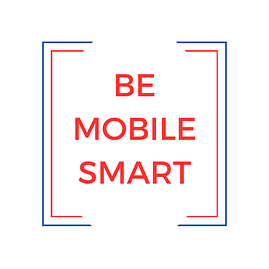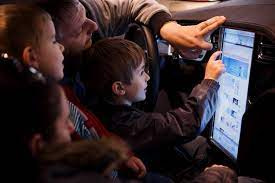You might remember when Mom told you not to read in the car because it would make you carsick, but what would she say today? Well before they are able to read words, young children are engrossed with the dashboard display, aka the big screen in the front seat.
Kids and screens are getting together in ways that the AAP, the American Academy of Pediatrics never imagined. Screentime in cars falls outside the AAP recommendation that parents keep their children away from screens until they are 18 months old, and then limit digital media to one hour per day.
Today’s vehicles have giant screens, sometimes as large as the TV back home. These screens are the interface between car functions, the driver and the road. In a Tesla, for example, the screen displays vital information the driver needs to change lanes, check their speed, and, of course, get directions.
Facing Inward:
These big screens can also become the interface between tiny passengers and the outside world. It’s not that children are playing games on the big screen while the adult drives- even the most basic software blocks that function. But, from the earliest age onward children are inculcated into a screen-driven universe. There is little or no research yet on these mobile screens. But we can conjecture that a child’s attention is likely to be hijacked towards the in-vehicle screen, just as a teen’s attention might be riveted to say, their smartphone.
Researchers in communication studies worry about the role of “attention stealers”. Background television is frequently studied and found to have negative effects. There are many reasons, but one that is relevant for in- vehicle travel, is that children end up dividing their focus across multiple channels. That is not good for their focused learning. Equally important, the presence of the screen is likely to decrease the dialogue between parent and child.
When the car is parked, the screen provides an opportunity to play a game or stream a video- but that is not the real story. The real story is outside the car, while it’s moving.
Partial Attention:
A young child who is giving partial attention to the car screen is also paying partial attention to the landscape they are moving through. They might miss the repetitive patterns, say a red octagonal shaped sign and a red flashing light, that they then associate with the vehicle slowing down. Or, the connection between black and white zebra- stripes on the pavement and proximity to a school building. With partial attention children are likely to overlook the meta messages about driving; perhaps the third set of eyes on the road that internalizes stopping distances, reading road signs and so forth. But, it’s not all negative. They are learning how to read maps on the screen and discovering that driving can be gamified.
Few parents want to return to the childhood litany that whines “Are we there yet” or “ How much longer will this take.” However, just like full attention to the outside, boring travel time is not without purpose. Child development specialists emphasize that learning to manage downtime is a vital skill for a young child’s self-regulation, creativity, and agency.
Shades down:
That said, parents and grandparents who drive today are not zombies, focused just on the road and screen. They still ask their children what music they want to listen to over the radio or playlist. They make sure kids are safe and buckled up. But, they may be less likely to make small talk with infants, or invent activities for older children, like adding up the numbers on a license plate or playing long-trip car games. Many of those games can help children overcome boredom, and also learn to focus and search for things outside the window.
It doesn’t happen only in cars- if you have taken a long-distance train or airplane, you will notice that the shades are pulled down. It’s so that passengers onboard can eliminate the glare on the video screen. Airplane trips now take place in a hushed, night time atmosphere, even when it’s a sunny day outside the window. This continues to remind us that looking outside the window is boring and looking at the screen is an alternate life.

